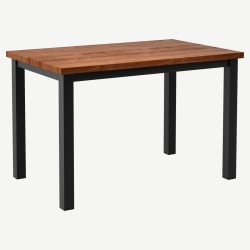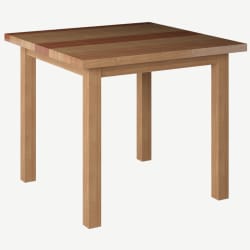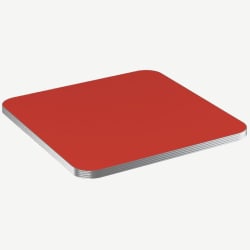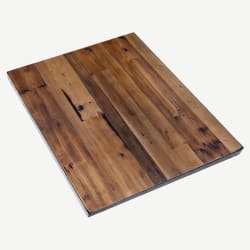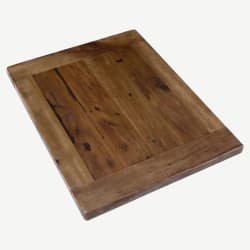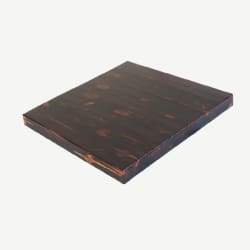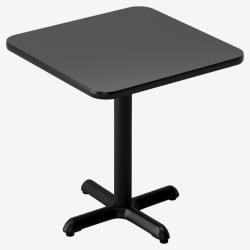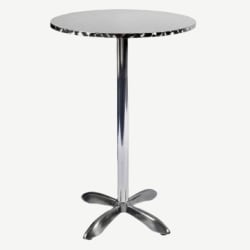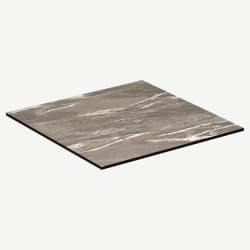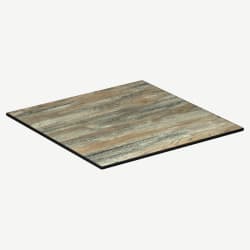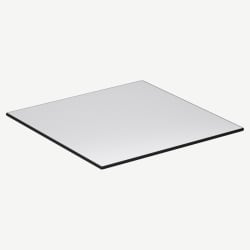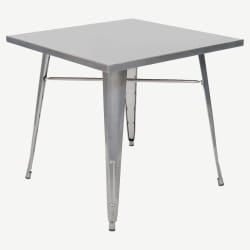Restaurant Tables
Tips for Choosing a Commercial Table
Consider Your Space
Seating capacity is determined by the number of tables you can fit while adhering to spatial requirements and customer comfort needs. Here are some things to take into consideration:
- Measure Your Space: - Find the dimensions of your total dining area. We recommend allowing 36” between the edge of the table and the wall or other furniture. Ensure that there is enough room to pull the chairs out. You will need at least 18”-24” clearance. You will also need 48” from the table to any doorways and entryways. Space between tables is recommended to be at least 18”, and space between chairs should be about 6”.
- Remember ADA Requirements - The Americans with Disabilities Act of 1990 ensures people in wheelchairs or with other disabilities can access restaurant seating without difficulty. Therefore, there are some requirements for available space needed to accommodate them. Approximately 61 million people in the US have some sort of disability. It is essential to provide seating options that will fit their needs. There needs to be a clear floor space with a minimum width of 30” and a minimum depth of 48” at selected tables, allowing guests to easily maneuver their wheelchairs and move to and from their table.
At least 5% of the dining tables at a restaurant must have a height of between 28” & 34”. This allows individuals in wheelchairs or with limited mobility to sit and dine without any obstruction. Aisles and pathways must have a minimum width of 36”.
Materials
There are many types of tables, constructed from different materials with different intended uses. Below you will find a breakdown of materials and the advantages and disadvantages of each:
- Solid Wood - Most often found in high-end dining and traditionally themed venues, solid wood table tops are a beautiful addition to any space. Their natural wood grain compliments any décor theme. However, these tops come with maintenance requirements to keep their appearance over time. It is recommended to apply furniture polish every several months to protect the table from water damage and keep it looking new.
- Laminate - Perfect for fast-casual dining, cafes, and other high-traffic environments, laminate tables are scratch resistant and easy to maintain. Some laminate tables also come with a wood-look, but without the upkeep. Others have a stone or marble look, but without the expense and hassle of real stone tables. The main advantage is durability and maintenance is simple. All that is needed is some soap and water to keep these tables looking new for years.
- Veneer - Veneer table tops are made from thin layers of hardwood, sliced or peeled from a log and adhered to a substrate such as medium density fiberboard or particle board. These tables resist the warping and cracking that can occur with solid wood tables. While offering the look of wood, these tables are less expensive and easier to maintain, with their easy to clean, stain resistant finish.
- Resin - Perfect for spaces with high-traffic and heavy use, resin tables are crafted with a mix of resin and hardener, offering a durable and practical solution for venues that need low-maintenance and easy to clean tables. Many of these can be used both indoor and out, thanks to the UV and weather-resistant properties of resin.
- Stainless Steel - Popular in vintage themed venues such as ice cream shops, and also good for patio use, stainless steel is resistant to heat, rust, and corrosion. They are low-maintenance and easy to clean, making them a durable option for both indoor and outdoor use.
- Synthetic Teak - Synthetic teak is known to perfectly mimic real teak wood, but is a water and weather-proof alternative, perfect for outdoor use. Maintenance is simple - you just need some soap and water. These tables are also UV resistant, allowing them to maintain their look after long periods exposed to the elements.
- Granite - Popular for its stain, scratch, and burn resistance, granite table tops are constructed with a thickness of 1 1/4” with a 1” plywood core. Extremely durable, these tops can handle abuse. However, to prevent moisture absorption, it is recommended to have the top resealed every year.
Size & Shape
The shape of your table makes all the difference when considering the number of people you wish to seat, as well as the average numbers in the parties you serve:
- Rectangular Tables - The most popular of shapes, rectangular tables can seat large groups of patrons easily, and tables can be put together on the short end to seat even more. More flexible than round or square shapes, rectangular tables allow for more people to be comfortably seated while taking up less overall space.
- Square Tables - Square tables create a sense of intimacy, allowing for equal space between patrons and ease of conversation with all seated parties. In contrast to rectangular tables, where some patrons are seated at the short end, everyone will feel equal with a square table size. As well, for square shaped dining areas, long rectangular tables can make the space feel cramped, while square tables will offer a more symmetrical look and feel. A drop leaf function is available on many, changing the table shape to round, allowing for increased seating capacity without using multiple tables.
- Round Tables - Round tables provide a good use of space, as there is less bumping and crowding when patrons sit down. Perfect for intimate parties, these tables foster a good conversational experience and can create a cozy atmosphere.
Frequently Asked Questions
What Table Top Size do I Need?
The short answer is it varies, however there are some standards. Take into consideration the average numbers in parties at your venue. Then draw up a seating plan based on available space and how many people you need to plan to seat. Below are some general guidelines:
- 2 people - It is recommended to use a 24” round or 24” x 24” square table
- 4 people - Minimum sizes range from 30” x 30” square to 36” round or 24” x 48” rectangle
- 6-8 people - Minimum sizes range from 42” x 42” square to 48” round to 30” x 60” rectangle
- More than 8 people - As it is not common to have parties greater than 8, we recommend using a drop leaf or placing several rectangular tables together on the short end
What is a Drop Leaf Table?
A drop leaf table allows you to turn a square table into a round one, with hinged leaves supported by brackets. It has a fixed section in the center and a leaf section on the corners, with hinges that allow the leaves to be opened and locked in place. This type of table is great for venues with space requirements, as the table can either be used in its original size or expanded to seat more patrons, without having to combine multiple tables.
We hope we have answered many of your questions with this guide. If you have further questions or need assistance in choosing the best table for your venue, please contact our team of experts. With years of experience in the industry, we can guide you towards the perfect table type, shape, and size for your unique vision. Call us today and get started enhancing your commercial space.




















